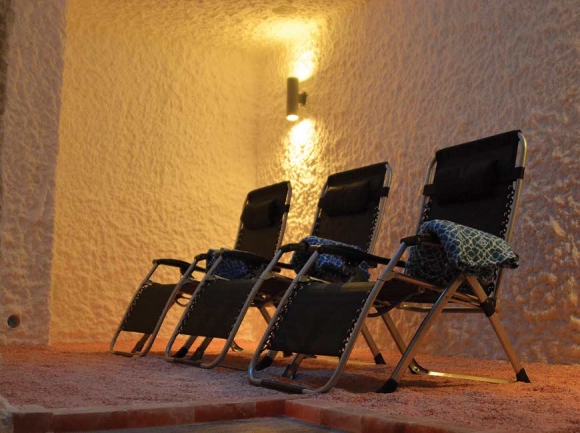Waynesville Salt Room now open
 A rainbow of relaxation awaits at the Waynesville Salt Room. Cory Vaillancourt photo
A rainbow of relaxation awaits at the Waynesville Salt Room. Cory Vaillancourt photo
Why don’t Polish salt miners ever get sick?
No, it’s not a joke, according to Marisa Spagnoli, owner of Waynesville Salt Room, a new Montgomery Street business that’s capitalizing on one of the latest trends in the spa industry.
“Natural caves of salt mines are only found in Poland,” said Spagnoli. “They were trying to find out why salt miners didn’t get sick like the other miners did, and so they did a big study in Russia.”
What they found, according to the study, is what some people have known for millennia — halotherapy helps people improve their breathing, their skin and their mood.
From the Greek word “halo,” meaning salt, halotherapy can be beneficial to those suffering from upper airway viral infections, allergic rhinitis, asthma, bronchitis, COPD, emphysema, cystic fibrosis, eczema, atopic dermatitis, post-surgical scar healing, pharyngitis, psoriasis, sick building syndrome, smoker’s cough, tonsillitis sinusitis and multiple chemical sensitivity syndrome.
An aesthetician by trade, Spagnoli owned day spas in Florida for over 20 years and still runs an online skincare company but opened her business in Waynesville to save Western North Carolinians the costly and time-consuming trip to Poland.
Related Items
“I moved up to Waynesville and tried to figure out what we need to do here to benefit the community, so we spent a lot of time visiting businesses and really getting to know Waynesville,” she said. “I fell in love with Waynesville, and just decided that we needed a salt room — a really good, a state-of-the-art facility.”
Although there are similar facilities in the region to the east, what makes Spagnoli’s business special is that it’s what’s called an active halochamber. Others are passive halochambers.
“Passive is not a breathable cleansing for the lungs,” said Spagnoli. “We have a machine that is a medical device called halogenerator. What it does is it takes pharmaceutical-grade salt and grinds it down to less than 5 microns, which turns it into an aerosol, also known as a dry salt aerosol.”
Air is drawn in from outside the building, and then passed through an 8-inch HEPA filter, and then passed through all-new HVAC ductwork Spagnoli installed in the building. It’s then run through the halogenerator and pumped into a small room.
“Generally, you’re going to feel very relaxed and energized and refreshed,” she said.
And that may be an understatement — the room has reclining “zero-gravity” chairs, and for optimum absorption is kept at a constant temperature of around 70 degrees with less than 50 percent humidity. The floor consists of gravel-sized grains of pink Himalayan salt … and then there’s the walls.
“It’s a proprietary process,” she said of her three-week endeavor to coat the walls — and ceiling — with pure white salt. “It’s hand-applied, inspected daily for cracks, and vigorously maintained.”
Tiny LED lights dot the ceiling, changing color in soothing, darting patterns, but a set of wall-mounted lighting can be adjusted to display a variety of comforting colors that contribute to the calming, dimly-lit atmosphere, along with soft ambient music that emanates from speakers above.
In such a pacifying spa-like setting it’s easy to forget that it’s the halotherapy treatment that’s most important, but it couldn’t be much easier to stop in for a relaxing session, even on a quick lunch break from work.
“It’s come-as-you-are, no special clothing or preparation is required, and you don’t have to undress,” said Spagnoli.
Surgical booties are worn over shoes, to avoid introducing adulterants into the salt floor. Sessions last 45 minutes, begin at the top of every hour, and can accommodate up to six people at a time. There’s a small charge for a private session and appointments are recommended. Otherwise it’s first come, first served.
“The halogenerator is computerized, and I can set the parameters for each session, so depending on who’s in the room and what they’re dealing with I’ll adjust the dosage based on the people in the room,” she said.
There’s also almost no indication that patrons are being subjected to concentrations ranging from 1 to 16 micrograms of aerosol salt per cubic meter; there’s no salty taste, nor does it irritate the eyes or soil the clothes.
A wall-mounted laser detector constantly measures the concentrations, and feeds the data back to a computer that tells the halogenerator whether or not to grind more salt.
“During the session the micro-particles of salt are visible in the laser, but it’s pretty much the only way you can tell,” said Spagnoli.
It’s also completely safe. There are no special building codes for this type of facility, no special medical license needed to administer halotherapy and it’s not regulated by the U.S. Food and Drug Administration, or anyone else.
“Really, nothing can go wrong,” she said, although people with some conditions like tuberculosis should refrain from treatment — not because it’s a danger to them, but because it could be a danger to others.

Proprietor Marisa Spagnoli has created a healthy and relaxing place in the heart of downtown Waynesville.
After the 45-minute session is over, a high-speed evacuation fan kicks on, sucks all the air out of the room, vents it to the outside and replaces it with all new air.
“That happens every session,” she said. “There’s a separate set of ducts and dampers that allow air to come into the room and air to be evacuated via computer.”
The Waynesville Salt Room offers a variety of individual plans and packages, including lower pricing for children under 13. Multiple session plans as well as family and unlimited plans are also available.
For more information or to book a session, find the Waynesville Salt Room on Facebook, Twitter or Instagram, call 828.246.0788, or visit www.waynesvillesaltroom.com.









